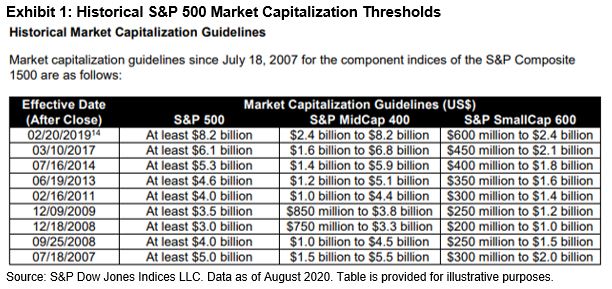Growth style investing has outperformed value for over a decade but its relative returns against value so far in 2020 have been unprecedented: the S&P 500® Growth index boasts its highest-ever year-to-date relative returns (+32%) versus its value counterpart through the third quarter. This comes despite growth’s eight-month winning streak coming to an end in September.

Amid declining interest rates earlier this year and growth companies’ higher sensitivities to discount factors, it is perhaps unsurprising that growth’s year-to-date relative returns have been driven by the outperformance of the most growth-like names in the market. Indeed, the total index market capitalization of “pure growth” S&P 500 companies—those with a growth exposure score of one, meaning they have 100% of their free-float market capitalization allocated to the S&P 500 Growth index—rose by nearly USD 3 trillion in the first three quarters of 2020. This increase was larger than the United Kingdom’s USD 2.2 trillion index market capitalization in the S&P Global BMI at the end of September.
In comparison, the collective index market capitalization of “pure value” companies dropped by USD 1.64 trillion since the end of 2019, and there were declines of USD 0.09 trillion for “middle” companies – those whose capitalization is distributed between the S&P 500 Growth and Value indices.

Much has been written recently about the outperformance of the largest names in the market in 2020, prompting concentration concerns by some market participants. Exhibit 3 shows that the five largest companies in the S&P 500 currently account for around 23% of the index, similar to the levels observed in the 1970s and up from 17% at the end of 2019.

Given that all five of the largest names in the S&P 500 are classified as “pure growth” companies, their outperformance also led to higher concentration in the S&P 500 Growth index. Exhibit 4 shows that the Herfindahl- Hirschman Index (HHI) for the growth index reached an all-time high at the end of August, with the five largest names in the index accounting for nearly 39% of the index. In contrast, the HHI measure for the value index hit an all-time low earlier this year.

For active managers looking to deliver excess returns over the benchmark, elevated index concentrations means having (correct) views over the fortunes of the largest index constituents—and changing allocations accordingly—is more valuable. Results from our Mid-Year 2020 U.S. SPIVA® Scorecard suggest that many active managers correctly identified this year’s growth trends and over-weighted the largest, most growth-like companies in the market: 75% of U.S. large-cap growth equity funds beat the S&P 500 Growth Index over the 12-month period ending June 30, 2020.
In contrast, over 70% of large-cap value managers underperformed the S&P 500 Value index over the same horizon. Much lower levels of index concentration and the more varied reactions of the value index’s constituents amid the “COVID correction” appeared to make it more difficult to identify trends in value.

As a result, the outperformance of the largest, most growth-like names in the market has propelled growth to its record-breaking relative returns compared to value, and appeared to help many growth managers to outperform recently. However, SPIVA results show how difficult it has been for active managers to outperform across the size and style spectrum, especially over longer horizons, and our Fleeting Alpha report shows that past (out)performance is no guarantee of future results. In other words, it is worth remembering that the index advantage is not a coincidence.
The posts on this blog are opinions, not advice. Please read our Disclaimers.














































 Clearly, the S&P 500 GICS sector weights have typically been similar to the large-cap portion of the S&P TMI. And while some differences have emerged in 2020, the S&P 500 remains representative of the large-cap U.S. equity space. The index is doing its job.
Clearly, the S&P 500 GICS sector weights have typically been similar to the large-cap portion of the S&P TMI. And while some differences have emerged in 2020, the S&P 500 remains representative of the large-cap U.S. equity space. The index is doing its job.


